18 March 2024
From For Evermore: Victoria Cross recipients
We return to For Evermore for a selection of inspirational stories of incredible bravery with a look at some Victoria Cross winners.
From For Evermore
What is the Victoria Cross?

Image: A Victoria Cross medal (© IWM OMD 2406.1)
The Victoria Cross (VC) is Britain’s highest award for military valour.
VCs are given for “most conspicuous bravery, or some daring or pre-eminent act of valour or self-sacrifice, or extreme devotion to duty in the presence of the enemy”.
Anyone serving in the British military is eligible for a VC. There are no barriers of race, creed, sex, or rank.
During the World Wars, the Commonwealth nations were parts of the British Empire. As such, servicemen from around the world have been awarded Victoria Crosses.
By their very nature, however, to even be considered for a VC, one must hurl themselves into harm’s way with complete disregard for their safety. Many Victoria Crosses are posthumous for this very reason.
How many Victoria Crosses have been awarded?
1,358 Victoria Crosses have been awarded since the medal’s inception in 1856.
626 Victoria crosses were given out during the First World War. 181 were awarded in the Second World War.
Commonwealth War Graves commemorate 379 Victoria Cross recipients.
On For Evermore, our digital casualty stories archive, we are chronicling the stories of the World Wars’ fallen VC winners. Here’s a small selection of those we found particularly moving, interesting and inspirational.
Major Edwin “Ted” Swales VC
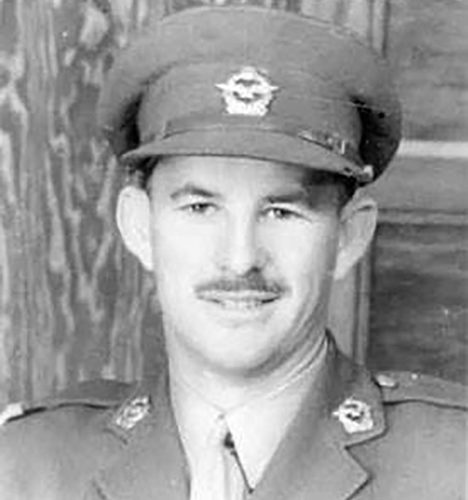 Edwin Swales, best known as Ted, was born in South Africa on 3 July 1915.
Edwin Swales, best known as Ted, was born in South Africa on 3 July 1915.
Ted’s first love was rugby. He played as a boy and a man, with civilian teams and military sides upon joining the armed forces.
Ted worked for Barclays Bank before embarking on his military career.
Joining the Natal Mounted Rifles in 1935, eventually reaching the rank of Warrant Officer 2nd Class.
In the early years of the Second World War, Ted saw action in Kenya, Abyssinia, and North Africa. But rather than sticking with the terrestrial roles, Ted’s destiny lay in the air.
Ted joined the South African Air Force, earning his pilot wings in June 1943. He was soon seconded to the Royal Air Force (RAF) but retained his ZA rank and uniform.
Ted was soon a Bomber Command pilot, commanding a Lancaster as a member of 582 Squadron, RAF Pathfinder Force.
On February 23 1945, Ted was piloting his aircraft over Pforzheim, Germany when the following action took place that saw him posthumously awarded the Victoria Cross:
“Captain Swales was 'Master Bomber' of a force of aircraft which attacked Pforzheim on the night of February 23, 1945. As Master Bomber he had the task of locating the target area with precision and of giving aiming instructions to the main force of bombers in his wake.
“Soon after he reached the target area he was engaged by an enemy aircraft and one of his engines was put out of action. His rear guns failed. His crippled aircraft was an easy prey for further attacks. Unperturbed, he carried on with his allotted task; clearly and precisely he issued aiming instructions to the main force.
“Meanwhile, the enemy fighter closed the range and fired again. A second engine of Captain Swales' aircraft was put out of action. Almost defenceless, he stayed over the target area issuing his aiming instructions until he was satisfied that the attack had achieved its purpose.
“It is now known that the attack was one of the most concentrated and successful of the war. Captain Swales did not, however, regard his mission as completed. His aircraft was damaged. Its speed had been so much reduced that it could only with difficulty be kept in the air. The blind-flying instruments were no longer working.
“Determined at all costs to prevent his aircraft and crew from falling into enemy hands, he set course for home.
“After an hour he flew into a thin-layered cloud. He kept his course by skilful flying between the layers, but later heavy cloud and turbulent air conditions were met. The aircraft, by now over friendly territory, became more and more difficult to control; it was losing height steadily.
“Realising that the situation was desperate Captain Swales ordered his crew to bail out. Time was very short and it required all his exertions to keep the aircraft steady while each of his crew moved in turn to the escape hatch and parachuted to safety.
“Hardly had the last crew member jumped when the aircraft plunged to earth. Captain Swales was found dead at the controls.
“Intrepid in the attack, courageous in the face of danger, he did his duty to the last, giving his life that his comrades might live.”
Ted was originally buried in the US cemetery at Fosse but his remains were later interred in Leopoldsburg War Cemetery, Belgium.
Ted was one of three Pathfinders to win the Victoria Cross in the Second World War and the only member of the South African Air Force to be awarded this highest of honours.
Second Lieutenant Moana-Nui-a-Kiwa Ngarimu VC
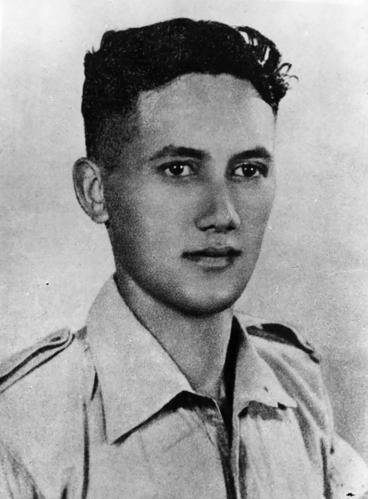 One of 10 children born into a prominent Māori family, Moana-Nui-a-Kiwa Ngarium was born on 7 April 1918.
One of 10 children born into a prominent Māori family, Moana-Nui-a-Kiwa Ngarium was born on 7 April 1918.
Moana came from a distinguished background. Moana’s aunt, Materoa Reedy, was a prominent community leader and campaigned tirelessly for Māori rights.
Before his military service, Moana worked as a shepherd on the family farm. Outside of work, Moana was a keen rugby player.
On the outbreak of the Second World War, Moana enlisted in the Army, joining the 28th (Maori) Battalion, New Zealand Expeditionary Force.
As its name suggests the 28th Battalion was a Māori-only unit. The 28th performed incredibly well in theatres including Greece, North Africa, and Italy during the Second World War, ending the conflict as New Zealand’s most decorated unit.
Moana’s wartime journey took him to Egypt where he was commissioned as a Second Lieutenant given command of his own platoon.
Following victory at El Alamein in November 1942, the war in North Africa shifted to Tunisia and the 28th Battalion was involved in the thick of the fighting.
Moana was killed in action during fighting to secure Hill 209: a strategically important piece of high ground near the Tebaga Gap, an important Tunisian mountain pass.
Such was Moana’s heroics in death, he was posthumously awarded the Victoria Cross for the following action:
“Darkness found this officer and his depleted platoon lying on the rock face of the forward slope of the hill feature, with the enemy in a similar position on the reverse slope about twenty yards distant.
“Throughout the night the enemy repeatedly launched fierce attacks in an attempt to dislodge 2nd Lieutenant Ngarimu and his men, but each counterattack was beaten off by 2nd Lieutenant Ngarimu's inspired leadership.
“During one of these counterattacks the enemy, using hand grenades, succeeded in piercing a certain part of the line. Without hesitation, this officer rushed to the threatened area and those of the enemy he did not kill he drove back with stones and with his Tommy-gun.
"During another determined counter-attack by the enemy, part of his line broke. Yelling orders and encouragement, he rallied his men and led them in a fierce onslaught back into their old positions.
“All through the night, between attacks, he and his men were heavily harassed by machine-gun and mortar fire, but 2nd Lieutenant Ngarimu watched his line very carefully, cheering his men on and inspiring them with his personal conduct.
“Morning found him still in possession of the hill feature but only he and two unwounded other ranks remained. Reinforcements were sent up to him. In the morning the enemy again counter-attacked and it was during this attack that 2nd Lieutenant Ngarimu was killed.
“He was killed on his feet defiantly facing the enemy with his Tommy gun at his hip.
“As he fell he came to rest almost on top of those of the enemy who had fallen, the number of whom survived testified to his outstanding courage and fortitude.”
Second Lieutenant Moana-Nui-a-Kiwa Ngarimu is today buried alongside his comrades in Sfax War Cemetery, Tunisia.

Introducing For Evermore: Stories of the Fallen - the exciting new way to read and share stories of the Commonwealth's war dead. Got a story to share? Upload it here and preserve their memory for generations to come!
Tell Your Story For EvermoreCaptain Frederick Thornton Peters
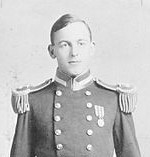 Frederick Thornton Peters was born on 17 September 1889, the son of Frederick Peters, Premier of Prince Edward Island, Nova Scotia, Canada.
Frederick Thornton Peters was born on 17 September 1889, the son of Frederick Peters, Premier of Prince Edward Island, Nova Scotia, Canada.
After completing his schooling in Canada, Fritz, as he was known, enrolled in Naval College in the UK. In 1905, Fritz entered the Royal Navy as a Midshipman. By the time of the First World War, he was a Lieutenant but retired from the Navy in 1919 as a Captain.
During the war, Fritz had been twice decorated, earning a Distinguished Service Order and a Distinguished Service Cross for his conduct at sea and in battle.
Fritz volunteered for naval service again at the outbreak of the Second World War. He was made the commander of an anti-submarine flotilla and was decorated again, earning a Bar for his DSC.
In 1942, Fritz was involved in Operation Reservist: an attempt to capture Oran Harbour, Algeria, in preparation for wider Allied North African landings under Operation Torch.
Unfortunately, Reservist was not a success. Two ships, HMS Walney and HMS Hartland came under heavy fire from coastal defences and enemy vessels during the attack on Oran.
Hartland was sunk by fire from the Vichy French destroyer Typhon with the loss of half her crew. Walney managed to reach to port jetty, she was set ablaze and sunk with a handful of survivors.
By all accounts, Captain Peters, aboard Walney, kept cool and led from the front during the debacle at Oran. Certainly, his actions that day were enough to posthumously earn a Victoria Cross.
Even so, the medal award citation, as published in the London Gazette, is low on details:
"Captain Peters led his force through the boom towards the jetty in the face of point-blank fire from shore batteries, a Destroyer and a Cruiser. Blinded in one eye, he alone of the seventeen Officers and Men on the bridge survived. The Walney reached the jetty disabled and ablaze, and went down with her colours flying.”
For his part at Oran, Fritz was also awarded a US Distinguished Service Cross. The medal citation for this accolade gives us a clearer picture of what happened that day in Algeria:
“Captain Peters distinguished himself by extraordinary heroism against an armed enemy during the attack on that post.
“He remained on the bridge in command of his ship in spite of the fact that the protective armour thereon had been blown away by enemy shell fire and was thereby exposed personally to the withering crossfire from shore defences.
“He then with utter disregard of his own personal safety went to the quarter deck and assisted in securing the aft mooring lines so that the troops on board could disembark.”
The survivors were taken prisoner and released on 10 November 1942 when Oran’s garrison surrendered.
Fritz was killed just three days later while returning to the UK in a Sunderland Flying Boat. He was killed when the plane crashed landed due to heavy fog in Portsmouth Harbour, despite the heroic efforts of pilot Wynton Thorpe.
Interestingly, Fritz has no known grave and is commemorated on the Portsmouth Naval Memorial.
Risaldar Badlu Singh VC
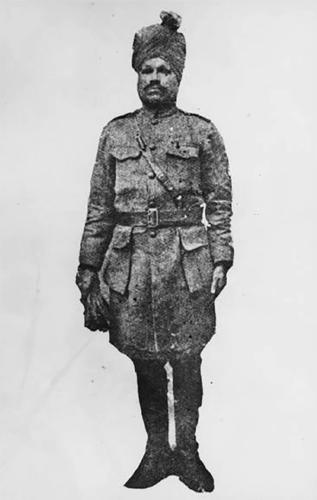 11 Indian army servicemen were awarded Victoria Crosses during the First World War. Amongst their number was Risaldar Badlu Singh.
11 Indian army servicemen were awarded Victoria Crosses during the First World War. Amongst their number was Risaldar Badlu Singh.
Badlu was born in the village of Dhakla, Jhajjar, Haryana, in 1876.
A career military man, Badlu was an Indian Army Officer, serving with the 14th Murray’s Jat Lancers. During the First World War, Badlu was transferred to the 29th Deccan Horse Lancers and was sent to France in 1914.
After surviving several years on the Western Front, Badlu and his men were posted to the Middle East where the Allies were fighting the Ottoman Empire.
September 1918. The British Army in Palestine was making a renewed push to knock the Ottomans out of the war. As part of this wider Middle East offensive, assaults were launched on Ottoman positions across the River Jordan.
On 23 September, Badlu’s squadron was advancing when they came under heavy fire. At the head of his horseman, Badlu led the charge that broke the enemy’s resistance. Sadly, he was fatally wounded in the attack.
For his actions, Badlu was posthumously awarded the Victoria Cross. His medal citation, published in the London Gazette, gives more details:
“For most conspicuous bravery and self-sacrifice on the morning of the 23rd September 1918, when his squadron charged a strong enemy position on the west bank of the River Jordan, between the river and Kh.es Samariveh Village.
"On nearing the position Ressaidar Badlu Singh realised that the squadron was suffering casualties from a small hill on the left front occupied by machine guns and 200 enemy infantry. Without the slightest hesitation he collected six other ranks and with the greatest dash and an entire disregard of danger charged and captured the position, thereby saving very heavy casualties to the squadron.
"He was mortally wounded on the very top of the hill when capturing one of the machine guns single-handed, but all the machine guns and infantry had surrendered to him before he died. His valour and initiative were of the highest order.”
Badlu has no known grave and so is commemorated on the Heliopolis (Port Tewfik) Memorial in Egypt.
Lieutenant Thomas Currie Derrick
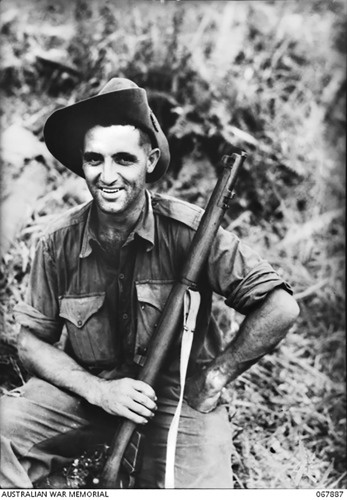 Thomas Currie Derrick, born on 20 March 1914 in Adelaide, Australia, held many odd jobs before becoming a soldier. But as soon as he was in uniform, it became clear Thomas was a truly gifted serviceman.
Thomas Currie Derrick, born on 20 March 1914 in Adelaide, Australia, held many odd jobs before becoming a soldier. But as soon as he was in uniform, it became clear Thomas was a truly gifted serviceman.
Enlisting in the Australia Imperial Force in July 1940, Thomas travelled to the Middle East with the 2/48th Battalion and soon distinguished himself in combat.
Thomas was promoted to corporal and was awarded the Distinguished Conduct Medal for bravery and leadership at the Tel el Eisa, earning another promotion to Sergeant.
After its time in Africa, the 2/48th returned to Australia for a period of rest before being transferred to Papua New Guinea in 1943.
In November, Thomas and the 2/48th were engaged in heavy fighting to take Sattelberg: the mountain overlooking the town of Finschafen.
Scaling steep cliffs while dodging machine-gun fire, used grenades and his rifle to clear ten Japanese outposts pouring money down on the attack ANZACs.
The following details of Thomas’ actions are taken from his Victoria Cross medal citation:
On 24th November, 1943, Sergeant Thomas Currie Derrick, D.C.M., was in command of a platoon of a Company of Australian Infantry ordered to attack a feature from the township of Sattelburg.
“For over two hours many unsuccessful attempts were made, under heavy fire from enemy strong points at the top of a precipitous cliff which the Company had to scale to reach the objective.
“The task appeared impossible, and shortly before last light the Company was ordered to retire. Sergeant Derrick requested, and was granted, permission to make one last attempt.
“Moving ahead of his forward section he personally destroyed with hand grenades an enemy post which had been holding up this section.
“His second section were heavily attacked by machine guns and grenades from six enemy posts.
“Without regard for his personal safety, he went ahead of the leading men and with grenades so completely demoralised the enemy that they fled leaving weapons and grenades.
“The Company was thus enabled to gain its first foothold on the precipitous ground. Then on four separate occasions Sergeant Derrick dashed forward and threw grenades at a range of 5 to 7 metres until the remaining three posts were silenced.
“In all he reduced ten enemy posts, and from the vital ground he captured the Battalion moved on and took Sattelburg.
“Undoubtedly the capture of Sattelburg was due to Sergeant Derrick's fine leadership and refusal to admit defeat in a seemingly impossible situation.
“His outstanding gallantry, thoroughness and devotion to duty were an inspiration not only to his platoon and company, but to the whole Battalion.”
The 2/48th returned to Australia in February 1944 and in August Derrick was posted to an officer training unit. He was commissioned as a lieutenant in November.
On 1 May 1945 he took part in the landing at Tarakan, Borneo.
Later that month he led his platoon against a heavily defended position code-named Freda, important high ground. That night a Japanese machine gun fired into the Australian lines. As he sat up to check that his men were all right, Derrick was hit by five bullets from the gun's second burst.
He had been lightly wounded before but recognised that this time his wounds were mortal. He died on 24 May 1945 and was buried in Labuan War Cemetery.
Share your casualty stories today on For Evermore
For Evermore: Stories of the Fallen is our online resource for sharing the memories of the Commonwealth’s war dead.
It’s open to the public to share their family histories and the tales of the service people commemorated by Commonwealth War Graves so that we may preserve their legacies beyond just a name on a headstone or a memorial.
If you have a story to tell, we’d love to hear it! Head to For Evermore to upload and share it for all the world to see.

